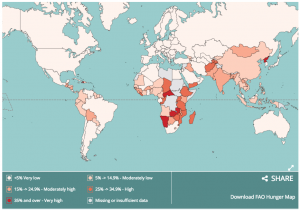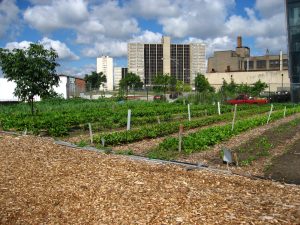The Desakota and the future of The Urban
The Desakota is a widespread phenomena that currently dominates the “less industrialized world,” (Moench & Gyawali 2008, p. 4) particularly in South Asia. However, in recent years, due to increased interest in urban food security (Benis & Ferrão 2016, p. 785), Urban and Peri-Urban Agriculture (UPA) is spreading throughout the global north.
The United Nations World Urbanization Prospects has reported that by 2050, approximately 67% of the world’s population will live in urban areas (United Nations 2014, pp. 1). The experience of food insecurity is typically discussed in the context of the global south, however, recent studies have shown that at least 12% of US households face limited food supply at some point during a year (Opitz et. al 2008, pp. 342). The global south has been facing these issues for some time and can provide examples and lessons that can be applied to the north. Jakarta’s experiments present problems of high urban density, frequent flooding, and high reliance on food imports vis-a-vis high levels of poverty. The experiments of UPA can be applied to other cities in the global south within similar contexts.

UPA in the global north has many forms, which are, as in the global south, undergoing constant experimentation. Economically, “by growing food in or near urban areas, one can more effectively deliver food to people and reduce the environmental costs of agriculture” (Martellozzo et. al 2014, pp. 2), as well as food transport costs (Martellozzo et. al 2014, pp. 2).
The Community Garden
The community garden, for example, which is a familiar concept in places like North America, typically involves the decision-making of neighbourhood groups and communal usage of agricultural space and resources to produce food sources (Opitz et. al. 2016, 343). In Montréal, “Lufa farms” is a profitable rooftop greenhouse, that aims to provide agriculture within the city. Lufa’s farm in Laval, Quebec, produces 120 metric tons of produce each year, roughly enough to feed 165 people per year based on an average North American consumption.

Limitations
The success of urban agriculture, in a North American context, though, can be limited to middle-to-upper class urbanites. Lufa, for example, is all organic in production, employs composting methods, and uses biocontrol and hydroponic techniques, which are at the cutting edge of agricultural production. It goes without saying that these methods increase the price of mass-produced cultivation methods; consequently, the economic and social sustainability of UPA in North American contexts should be highly suspect.
More information on Lufa farms here: http://lufa.com/en/
Below is an inspiring TED talk on community farming:
Conclusion/What’s Next?
Desakota farming in the global south can provide us with a view into adaptations possible for global north UPA. In desakota farming, low-income urban citizens provide their families with produce via subsistence farming. The absence of a low-income-inclusive UPA approach in the Global North has led to a proliferation of food deserts in low-income communities.
As the world becomes increasingly urban, we believe that the use of urban agriculture will become an increasingly used approach to providing food sources within local communities and globally.
Moving forward, some questions to ask:
- How can we deconstruct the divisions of ‘global north’ and ‘global south’ in finding solutions to the problem of increased urban food insecurity?
- Can lessons from north’s management of rooftop gardens, lend insights to urban agricultural practices in the south in terms of –
- Market access
- Production feasibility
- Community organization
- Leave a comment with your questions!
References
Benis, K. and Ferrão P. (2016). Potential mitigation of the environmental impacts of food systems through urban and peri-urban agriculture (UPA) – a life cycle assessment approach. Journal of Cleaner Production. 140, pp. 784-795.
Moench, M. and Gyawali, D. (2008). Desakota: reinterpreting the urban-rural continuum. Final Report Desakota II A. Natural Environment Research Council, pp. 1-27.
Martellozzo, F., Landry, J-S., Plouffe, D., Seufert, V., Rowhani, P., and Ramankutty, N. (2014). Urban Agriculture: a global analysis of the space constraint to meet urban vegetable demand. Environmental Research Letters. 9(6), pp. 1-8.
Opitz, I., Berges, R., Piorr, A. and Krikster, T. (2015). Contributing to food security in urban areas: differences between urban agriculture and peri-urban agriculture in the Global North. Agric Hum Values. 33(2), pp. 341-358.
United Nations. (2014). World Urbanization Prospects: The 2014 Revision. Department of Economic and Social Affairs. Pp. 1-27.